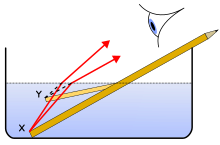 Posted by ROSHAN B.S on Aug. 24, 2014, 2:28 p.m.
Posted by ROSHAN B.S on Aug. 24, 2014, 2:28 p.m.
n optics, refraction is a phenomenon that often occurs when waves travel from a medium with a givenrefractive index to a medium with another at an oblique angle. At the boundary between the media, the wave's phase velocity is altered, usually causing a change in direction. Its wavelength increases or decreases but its frequency remains constant. For example, a light ray will refract as it enters and leaves glass, assuming there is a change in refractive index. A ray traveling along the normal(perpendicular to the boundary) will change speed, but not direction. Refraction still occurs in this case. Understanding of this concept led to the invention of lenses and the refracting telescope.
Refraction can be seen when looking into a bowl of water. Air has a refractive index of about 1.0003, and water has a refractive index of about 1.3330. If a person looks at a straight object, such as a pencil or straw, which is placed at a slant, partially in the water, the object appears to bend at the water's surface. This is due to the bending of light rays as they move from the water to the air. Once the rays reach the eye, the eye traces them back as straight lines (lines of sight).
